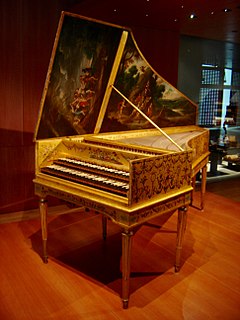The Flute sonata in E minor (HWV 359b) was composed (c. 1724) by George Frideric Handel for flute and keyboard (harpsichord). The work is also referred to as Opus 1 No. 1b, and was first published in 1732 by Walsh. Other catalogues of Handel's music have referred to the work as HG xxvii,6; and HHA iv/3,10.

George FridericHandel was a German, later British, Baroque composer who spent the bulk of his career in London, becoming well-known for his operas, oratorios, anthems, and organ concertos. Handel received important training in Halle-upon-Saale and worked as a composer in Hamburg and Italy before settling in London in 1712; he became a naturalised British subject in 1727. He was strongly influenced both by the great composers of the Italian Baroque and by the middle-German polyphonic choral tradition.

A harpsichord is a musical instrument played by means of a keyboard which activates a row of levers that in turn trigger a mechanism that plucks one or more strings with a small plectrum.

John Walsh was an English music publisher of Irish descent, established off the Strand, London, by c. 1690. He was appointed musical instrument-maker-in-ordinary to the king in 1692.
Contents
The sonata was originally composed as a violin sonata in D minor (HWV 359a). [1] The flute sonata version is a compound work—compiled by Handel himself. It is the only flute sonata for which an autographed manuscript survives (which is currently held in the British Library).
The Violin sonata in D minor was composed by George Frideric Handel, for violin and keyboard (harpsichord). The work is also referred to as HHA iv/18,10.

The British Library is the national library of the United Kingdom and the largest national library in the world by number of items catalogued. It is estimated to contain 150–200 million+ items from many countries. As a legal deposit library, the British Library receives copies of all books produced in the United Kingdom and Ireland, including a significant proportion of overseas titles distributed in the UK. The Library is a non-departmental public body sponsored by the Department for Culture, Media and Sport.
Of the two sonatas in the Chrysander edition as Opus 1 Sonata I, this one (Sonata Ib) is the one in the Walsh edition (where it is called Sonata I). Chrysander's Sonata Ia was compiled from manuscript sources. Chrysander's Sonata Ia and Sonata Ib have their first and fourth movements in common.

XV Solos for a German Flute, Hoboy, or Violin with a Thorough Bass for the Harpsichord or Bass Violin was published by Friedrich Chrysander in 1879. The 72-page volume contains sonatas, for various instruments, composed by George Frideric Handel. The words on the cover of the publication are: Sonate da Camera di G.F.Handel. The publication includes all the sonatas as published by Walsh in 1732; and those sonatas, as well as extras included by Chrysander, include the body of work that is known as Handel's "Opus 1".

Solos for a German Flute a Hoboy or Violin with a Thorough Bass for the Harpsichord or Bass Violin Compos'd by Mr. Handel was published by John Walsh in 1732. It contains a set of twelve sonatas, for various instruments, composed by George Frideric Handel. The 63 page publication includes the sonatas that are generally known as Handel's Opus 1.
The Flute sonata in E minor was composed by George Frideric Handel for flute and keyboard (harpsichord). The work is also referred to as Opus 1 No. 1a, and was first published in 1879 by Chrysander. Other catalogues of Handel's music have referred to the work as HG xxvii,2; and HHA iv/3,2.
A typical performance of the work takes about seven minutes.